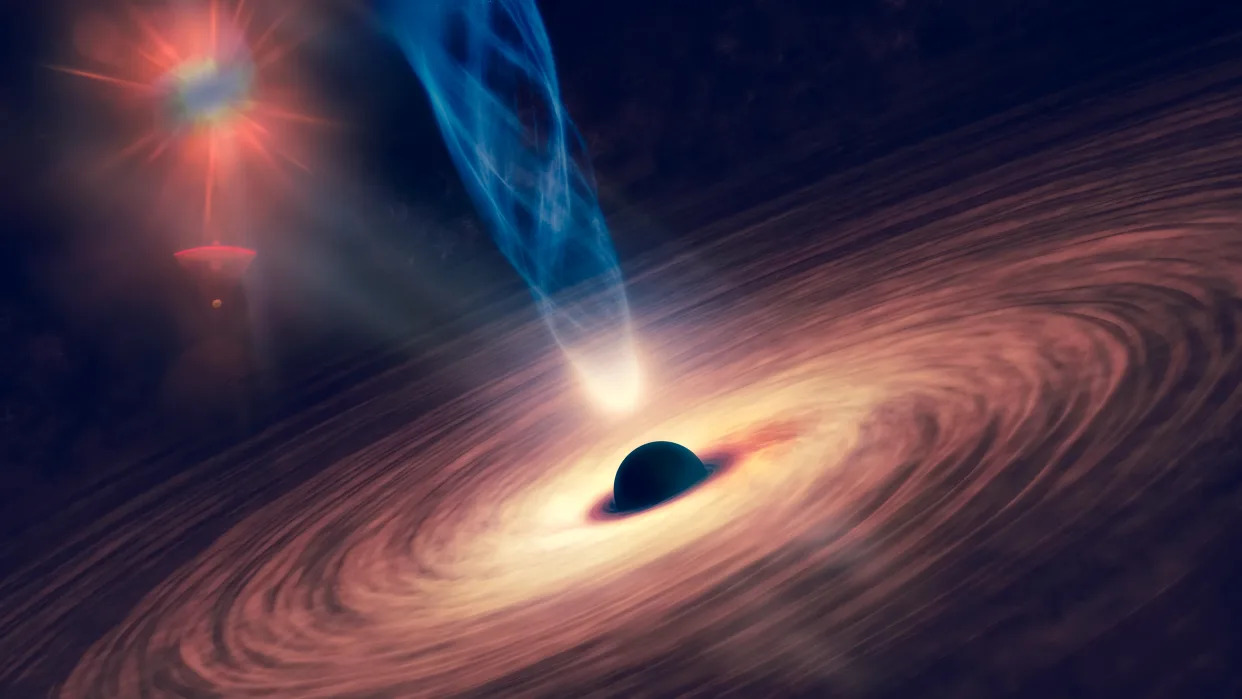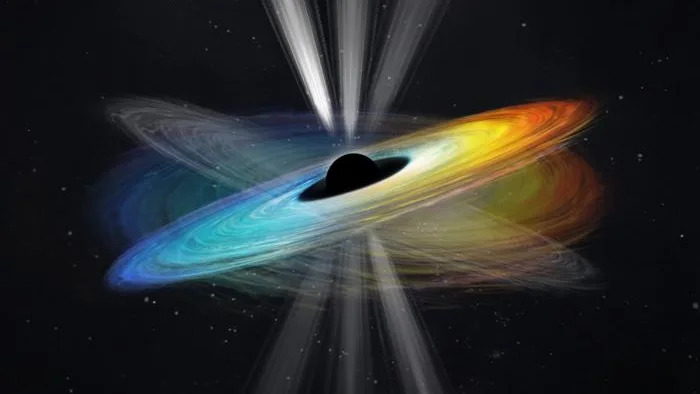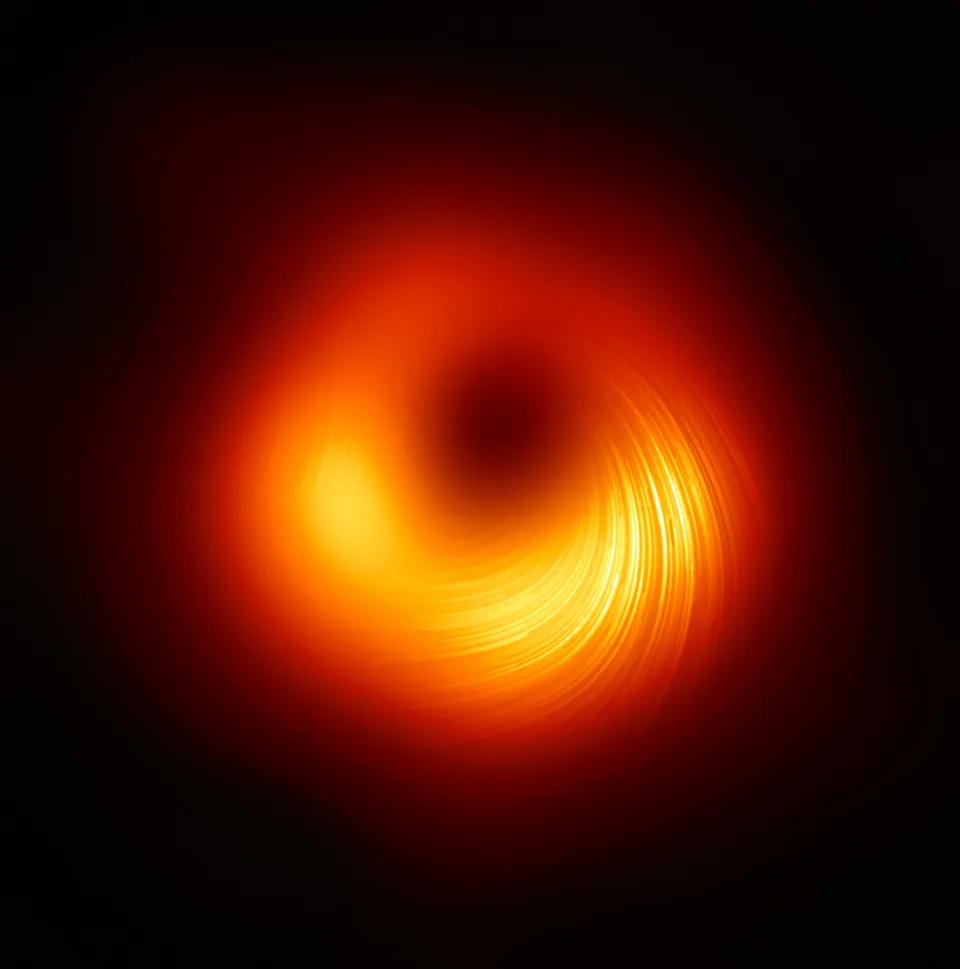Scientists confirm that the first black hole ever imaged is actually spinning
The researchers analyzed 22 years' worth of observations of the galaxy M87.
Mariella Moon
·Contributing Reporter
Thu, September 28, 2023

Elen11 via Getty Images
The first black hole humanity has ever imaged has also provided us with what researchers are calling "unequivocal evidence" that black holes spin. An international team of scientists headed by Chinese researcher Dr. Cui Yuzhu analyzed 22 years of observational data gathered by more than 20 telescopes around the world. What they found was that the black hole at the center of galaxy M87, which is 6.5 billion times more massive than our sun, exhibits an oscillating jet that swings up and down every 11 years. This phenomenon confirms that the black hole is indeed spinning.
Black holes gobble up huge amounts of gas and dust, which they attract with their massive gravitational pull. A small fraction of those particles that don't fall into the black hole get spewn out and travel close to the speed of light, showing up as narrow beams along the axis. These beams are called "jets." The telescopes' observations show that M87's jet oscillates by 10 degrees in a recurring 11-year cycle, just as predicted by Einstein's General Theory of Relativity.
The researchers analyzed 22 years' worth of observations of the galaxy M87.
Mariella Moon
·Contributing Reporter
Thu, September 28, 2023
Elen11 via Getty Images
The first black hole humanity has ever imaged has also provided us with what researchers are calling "unequivocal evidence" that black holes spin. An international team of scientists headed by Chinese researcher Dr. Cui Yuzhu analyzed 22 years of observational data gathered by more than 20 telescopes around the world. What they found was that the black hole at the center of galaxy M87, which is 6.5 billion times more massive than our sun, exhibits an oscillating jet that swings up and down every 11 years. This phenomenon confirms that the black hole is indeed spinning.
Black holes gobble up huge amounts of gas and dust, which they attract with their massive gravitational pull. A small fraction of those particles that don't fall into the black hole get spewn out and travel close to the speed of light, showing up as narrow beams along the axis. These beams are called "jets." The telescopes' observations show that M87's jet oscillates by 10 degrees in a recurring 11-year cycle, just as predicted by Einstein's General Theory of Relativity.
So, what causes the M87's jet to swing back and forth? The researchers' analysis indicates that the black hole's spin axis doesn't perfectly align with the rotational axis of its accretion disk. This disk-like structure is typically found surrounding a black hole, because it's made of materials that gradually spiral into the void to be consumed. That misalignment between the rotating mass and the matter that swirls around it causes "a significant impact on surrounding spacetime," which affects the movement of nearby objects in what the General Theory of Relativity calls "frame-dragging."
This is a significant discovery that massively improves our understanding of the mysterious region of spacetime — aside from proving Einstein right, of course. Scientists have yet to find out the size of M87's accretion disk and how fast its black hole is spinning, though, and that entails further observation and analysis.
Scientists just proved that 'monster' black hole M87 is spinning — confirming Einstein’s relativity yet again
Ben Turner
Thu, September 28, 2023

An artist's illustration of the black hole M87* wobbling on its axis.
Astronomers have found the first direct evidence of a black hole spinning, and it's confirmed Einstein's theory of relativity yet again.
The discovery was made by studying powerful jets of energy beamed from the solar system-size black hole at the center of the neighboring Messier 87 galaxy. The black hole, called M87, is the best studied black hole to date and the first to ever be directly imaged in 2019, with its "donut hole" shadow crowned by a fuzzy halo of light.
Astrophysicists have long predicted that black holes spun, but the challenge of imaging the cosmic monstrosities has, until now, made evidence hard to come by. The researchers published their findings Sept. 27 in the journal Nature.
Related: The closest black holes to Earth may be 10 times closer than we thought
"After the success of black hole imaging in this galaxy with the [Event Horizon Telescope (EHT)], whether this black hole is spinning or not has been a central concern among scientists," Kazuhiro Hada, an astronomer at the National Astronomical Observatory of Japan, said in a statement. "Now anticipation has turned into certainty. This monster black hole is indeed spinning."
Black holes have such a powerful gravitational pull that nothing (not even light) can escape their maws, but this doesn't mean they can't be seen. This is because active black holes are surrounded by accretion disks — vast plumes of material stripped from gas clouds and stars, heated to red-hot temperatures by friction as it spirals into the black holes' mouths.

Some of this material is spat out, forming two jets of hot material that, in roughly a tenth of cases, travels at 99.9% the speed of light. How black hole jets acquire the enormous energy needed to do this has been a mystery, but physicists used Einstein's general theory of relativity to suggest the material could get it from the cosmic monsters' magnetic fields, if they were spinning rapidly on their axes.
Black holes likely acquired some of their spin from their early days as stars that, as they suddenly collapsed inward, became like figure skaters pulling in their arms to rotate faster. Over time, this spin probably grew faster due to the effect of infalling matter from stars ripped apart by the black holes, or from catastrophic collisions with other massive objects.
To search for clues of this elusive spin, astronomers turned to the M87 supermassive black hole, an enormous space-time tear that uses its mass (6.5 billion times that of the sun) to anchor an entire galaxy.
By studying M87* using a global network of radio telescopes from 2000 to 2022, the astronomers found that the black hole's jets were ticking back and forth like metronomes marking out an 11-year cycle. This showed that the black hole was precessing or wobbling on its axis as it rotated, just like a spinning top.
"We are thrilled by this significant finding," lead author Cui Yuzhu, an astronomer at Zhejiang Lab in Hangzhou, China, said in the statement. "Since the misalignment between the black hole and the disk is relatively small and the precession period is around 11 years, accumulating high-resolution data tracing M87's structure over two decades and thorough analysis are essential to obtain this achievement."
Beyond confirming Einstein's theory yet again, a number of exciting questions emerge from the discovery of black hole spin. Among them are ones relating to what catastrophic events could have caused the rapid rotation, as well as the possibility of discovering photon spheres — a faint ring of light surrounding the black hole that could give important hints into a theory of quantum gravity.
No comments:
Post a Comment